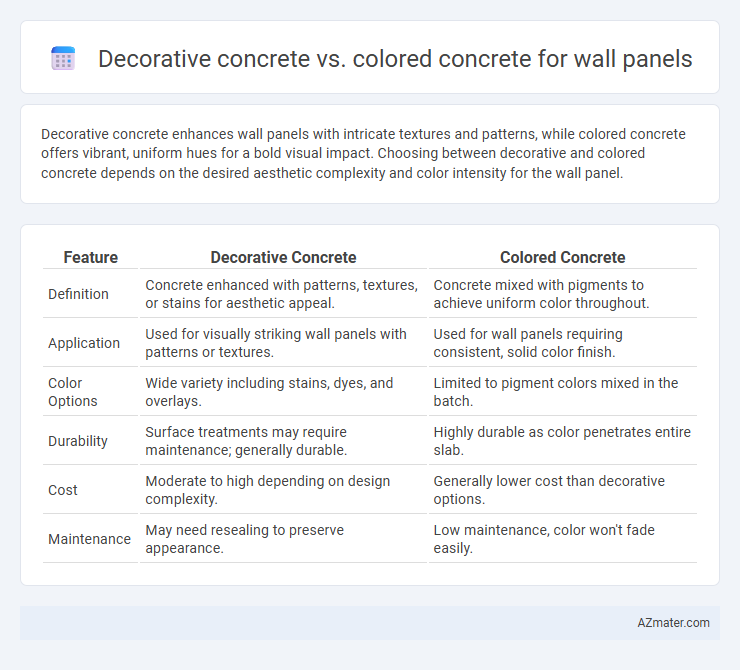Decorative concrete enhances wall panels with intricate textures and patterns, while colored concrete offers vibrant, uniform hues for a bold visual impact. Choosing between decorative and colored concrete depends on the desired aesthetic complexity and color intensity for the wall panel.
Table of Comparison
| Feature | Decorative Concrete | Colored Concrete |
|---|---|---|
| Definition | Concrete enhanced with patterns, textures, or stains for aesthetic appeal. | Concrete mixed with pigments to achieve uniform color throughout. |
| Application | Used for visually striking wall panels with patterns or textures. | Used for wall panels requiring consistent, solid color finish. |
| Color Options | Wide variety including stains, dyes, and overlays. | Limited to pigment colors mixed in the batch. |
| Durability | Surface treatments may require maintenance; generally durable. | Highly durable as color penetrates entire slab. |
| Cost | Moderate to high depending on design complexity. | Generally lower cost than decorative options. |
| Maintenance | May need resealing to preserve appearance. | Low maintenance, color won't fade easily. |
Introduction to Decorative and Colored Concrete for Wall Panels
Decorative concrete for wall panels enhances architectural aesthetics by incorporating textures, patterns, and surface treatments that mimic natural materials such as stone or wood. Colored concrete introduces pigmentation directly into the mix, allowing for consistent, durable hues that resist fading and weathering over time. Both techniques offer customizable design options, with decorative concrete emphasizing surface detail and colored concrete focusing on vibrant, integrated color solutions for long-lasting wall panels.
Key Differences Between Decorative and Colored Concrete
Decorative concrete for wall panels emphasizes texture, patterns, and finishes like stamping or engraving, creating visually intricate surfaces that mimic materials such as stone or wood. Colored concrete primarily involves the integration of pigments or dyes to uniformly alter the concrete's base color, offering consistent hues but limited surface variation. While decorative concrete enhances aesthetic complexity through tactile and visual detail, colored concrete focuses on monochromatic or multi-tone coloration without significant texture modification.
Types of Decorative Concrete Finishes for Wall Panels
Decorative concrete for wall panels offers a variety of textured and patterned finishes such as stamped, exposed aggregate, and acid-etched surfaces, enhancing visual appeal and architectural detail. Colored concrete incorporates integral pigments, stains, or dyes to create consistent or variegated hues while maintaining durability and weather resistance. Selecting between decorative and colored concrete hinges on desired aesthetic effects, with decorative finishes emphasizing texture and pattern and colored concrete focusing on uniform or customized color schemes.
Color Options and Techniques in Colored Concrete
Colored concrete for wall panels offers a diverse palette through integral pigments, stains, and dyes, enabling rich, uniform hues or subtle variations that decorative concrete typically cannot achieve. Techniques such as acid staining, water-based stains, and integral coloring allow precise control over color intensity and patterns, making colored concrete ideal for customized and vibrant wall aesthetics. Decorative concrete relies more on surface treatments and overlays, which may limit durability and color depth compared to the embedded pigmentation of colored concrete.
Durability and Maintenance Considerations
Decorative concrete wall panels often incorporate surface treatments like stamping or staining, which may require periodic sealing to maintain their appearance and resist wear, while colored concrete uses integral pigments mixed into the concrete, providing long-lasting color with minimal fading or chipping. Durability-wise, colored concrete offers superior resistance to UV exposure and weathering since the color penetrates the entire panel, reducing maintenance compared to decorative overlays that can be prone to surface damage. Maintenance for decorative concrete involves more frequent inspections and resealing, whereas colored concrete panels typically need only routine cleaning to preserve their aesthetic and structural integrity.
Aesthetic Impact: Visual Appeal for Wall Panels
Decorative concrete offers intricate textures and patterns that enhance the tactile and visual depth of wall panels, creating a sophisticated and artistic appeal. Colored concrete provides a consistent, vibrant hue that maintains its pigmentation over time, contributing to bold and uniform aesthetics without the need for additional finishes. Combining decorative elements with colored concrete can optimize the visual impact, delivering both texture and vivid color for striking wall panel designs.
Installation Process and Time Factors
Decorative concrete wall panels require detailed surface preparation and application techniques such as stamping, staining, or polishing, which can extend installation time compared to colored concrete panels. Colored concrete panels, produced by integrating pigments directly into the mix, typically allow for faster installation due to fewer finishing steps. Time factors depend heavily on curing duration and complexity of design, with colored concrete often offering a more efficient process for large-scale projects.
Cost Comparison: Decorative vs Colored Concrete
Decorative concrete wall panels typically involve intricate patterns, textures, or overlays, leading to higher labor and material costs compared to colored concrete, which primarily adds pigment for aesthetic appeal. Colored concrete offers a more budget-friendly option due to its simplified application process, requiring fewer specialized skills and materials. For large-scale projects, colored concrete reduces expenses significantly while decorative concrete justifies its premium pricing through enhanced design complexity and unique finishes.
Popular Applications in Modern Wall Panel Design
Decorative concrete offers versatile textures and patterns ideal for accent walls, creating visually striking and tactile surfaces in modern wall panel designs. Colored concrete provides consistent and vibrant hues, enabling designers to achieve precise color schemes and seamless integration with architectural elements. Both materials are widely used in commercial and residential spaces for their durability and aesthetic adaptability in contemporary interior and exterior wall applications.
Choosing the Best Option: Factors to Consider
Choosing between decorative concrete and colored concrete for wall panels depends on factors such as aesthetic preferences, durability requirements, and maintenance needs. Decorative concrete offers varied textures and finishes that enhance visual appeal, while colored concrete provides consistent pigmentation and long-lasting color integrity. Consider project-specific demands, environmental exposure, and budget constraints to select the best option for optimal performance and design impact.

Infographic: Decorative concrete vs Colored concrete for Wall panel
 azmater.com
azmater.com